The Sandy Bridge Preview
by Anand Lal Shimpi on August 27, 2010 2:38 PM ESTAdobe Photoshop CS4 Performance
To measure performance under Photoshop CS4 we turn to the Retouch Artists’ Speed Test. The test does basic photo editing; there are a couple of color space conversions, many layer creations, color curve adjustment, image and canvas size adjustment, unsharp mask, and finally a gaussian blur performed on the entire image.
The whole process is timed and thanks to the use of Intel's X25-M SSD as our test bed hard drive, performance is far more predictable than back when we used to test on mechanical disks.
Time is reported in seconds and the lower numbers mean better performance. The test is multithreaded and can hit all four cores in a quad-core machine.
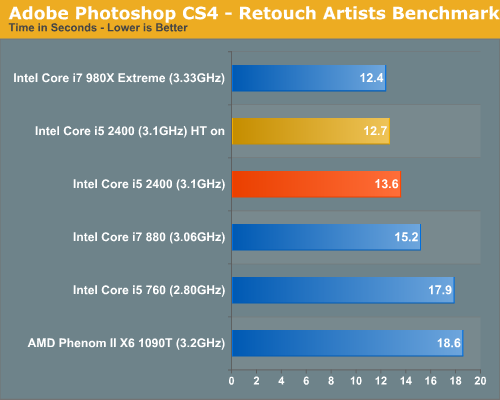
Right off the bat Sandy Bridge is killer. In our Photoshop test it’s faster than its closest quad-core price competitor, faster than its identically clocked Lynnfield, faster than AMD’s fastest and loses out only to Intel’s $999 Core i7 980X. That being said, it only takes about 9% longer to complete our benchmark than the 980X.
DivX 6.5.3 with Xmpeg 5.0.3
Our DivX test is the same DivX / XMpeg 5.03 test we've run for the past few years now, the 1080p source file is encoded using the unconstrained DivX profile, quality/performance is set balanced at 5 and enhanced multithreading is enabled:
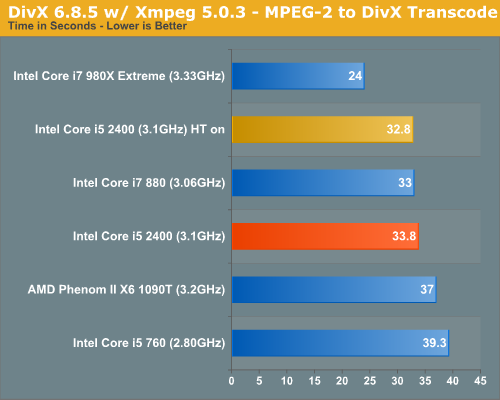
While not the most stressful encoding test, it’s still a valid measure of performance and once again, Sandy Bridge is faster than all. In this case we’re faster than the Core i5 760 (~16%) and just behind the Core i7 880. Clock for clock there's not a huge improvement in performance here (HT doesn't seem to do much), it's just a better value than the 760 assuming prices remain the same.
x264 HD Video Encoding Performance
Graysky's x264 HD test uses the publicly available x264 encoder to transcode a 4Mbps 720p MPEG-2 source. The focus here is on quality rather than speed, thus the benchmark uses a 2-pass encode and reports the average frame rate in each pass.
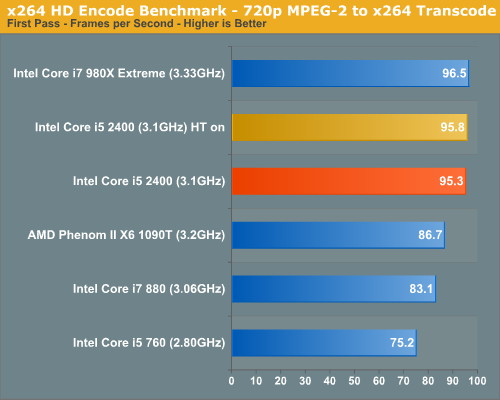
Lightly threaded performance is much improved - the 2400 is 14.6% faster than the Core i7 880.
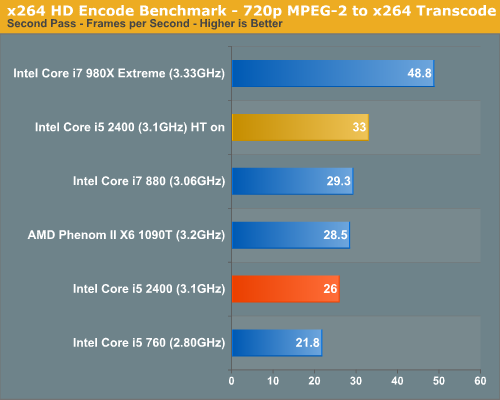
The actual encoding pass favors more threads, so we see a big improvement over the 760 (19%) but it falls short of the Core i7 880. Turn HT on and we get a 12.6% improvement over an identically clocked/configured Lynnfield.
Note that CPU based video encoding performance may not matter if Intel implemented a good video transcode engine in Sandy Bridge.
Windows Media Encoder 9 x64 Advanced Profile
In order to be codec agnostic we've got a Windows Media Encoder benchmark looking at the same sort of thing we've been doing in the DivX and x264 tests, but using WME instead.
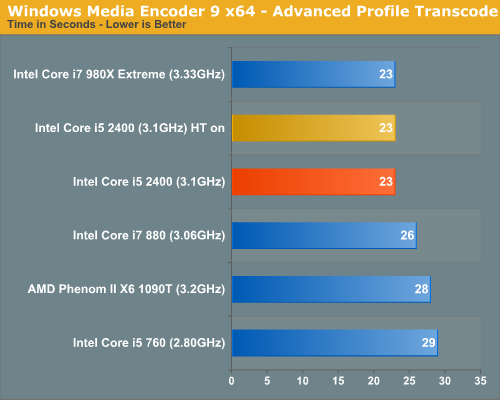
Performance in WME rarely scales anymore. Our benchmark doesn’t scale well beyond 4 cores and the only hope for performance are increases in clock speed or IPC. Sandy Bridge delivers the latter.
A 20% increase in performance vs. the similarly clocked 880 in a test that doesn’t scale with anything but IPC tells you a lot. Compared to the Core i5 760, Sandy Bridge is 26% faster.










200 Comments
View All Comments
tatertot - Tuesday, August 31, 2010 - link
Can you also confirm whether or not the GPU turbo was also disabled?DanNeely - Saturday, August 28, 2010 - link
Do you think Intel will be sharing preliminary performance/pricing data on LGA 2011 by the time that the first LGA 1155 parts start shipping? I'm on 1366 now and would like to know if staying on the high end platform will be a reasonable option or if there isn't any point in holding off for another 6 months on my upgrade.Anand Lal Shimpi - Saturday, August 28, 2010 - link
I wouldn't expect any near-final LGA-2011 performance data until Q2 next year, well after the LGA-1155 launch.Take care,
Anand
Casper42 - Saturday, August 28, 2010 - link
2 things jumped out at me1) No USB3 - Major FAIL. Putting USB3 in an Intel chipset will drive huge adoption rates rather than this limping in BS by manufacturers today. Not to mention that for Hard Drives, USB2 has been a bottleneck for a long time whereas only top end SSDs today are maxing out SATA3
2) 2 chips with Quad Core and no HT that are identical except for Clock speed and one of them is essentially the 400 and the other is the 500? WTF? Call them the 2410, 2420, 2430, etc. That gives you like 8 or 9 speed bins for that family. Whomever is doing the numbering at Intel needs a swift kick to the head to get them back on track mentally as things just get more and more confusing. You have the i3/i5/i7 today, why not just change it to:
i2 = Dual Core no HT/Turbo
i3 = Dual Core with HT and/or Turbo
i4 = Quad Core no HT/Turbo
i5 = Quad WITH
i6 = Six without
etc
As it stands now we have i5 with both dual and quad core and i7 with 4 and 6. just doesnt make sense.
dertechie - Saturday, August 28, 2010 - link
That's quite the IPC improvement there. Not quite Netburst to Core 2 but a lot more than I expected (I was expecting something on the order of 5%, with most gains coming from ramping clocks with the extra headroom of 32nm).Question is, do I want the i5-2500K more than I loathe Intel's motherboard department? I'm seeing them bring out new sockets almost as often as new processor families, which really, really does not make me confident in the socket's future.
I will wait at least for Bulldozer benches before buying whatever makes sense at that time (okay, probably weighted in AMD's favor). I've lasted 4 years on this Pentium D, I can live another half of one.
IntelUser2000 - Saturday, August 28, 2010 - link
Why do some people still compare Netburst vs. Core 2? The Pentium 4 generation was a clock speed focused that that FAILED to realize its clock speed potential so it looked really bad compared to Core 2.Compared to Core Duo Core 2 was only 15-20% faster. Sandy Bridge manages to do another 20%, which is really good in a generation, yea?
ssj4Gogeta - Saturday, August 28, 2010 - link
Pentium D to SB will be such a huuuuge jump, lol.neslog - Saturday, August 28, 2010 - link
Your excellent article was exciting to read. Thank you!I noticed a small typo on the Windows 7 Gaming Performance page in the first line under the Data Recovery chart : "Clock for clock...to the i7{5} 760..."
ET - Saturday, August 28, 2010 - link
I think that the integrated graphics here are a game changer. Sure nobody will look to them for serious gaming, but finally they're at a point where if you buy any CPU you will be able to play most games, even if at low settings. I'll be looking forward especially to the mobile CPU's. With Bobcat around the corner, I guess next year we will finally see mainstreams notebooks become capable of some game playing, which will be great (and bad for NVIDIA).Exodite - Saturday, August 28, 2010 - link
What I'd like to see is something like Nvidia's Optimus make it to the desktop. With both AMD and Intel going for on-chip integrated graphics the market is practically begging for a unified standard for graphics switching.The next-generation IGPs look to be competent enough for anything but high-end gaming, which means I should be able to power down my discrete graphics card completely most of the time. The end result would be significant reductions in noise generation, power usage and heat emissions.
Having discreet graphics cards reduced to basically connector-less, slot-in cards for on-demand co-processing seems the logical step.